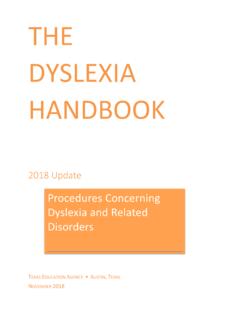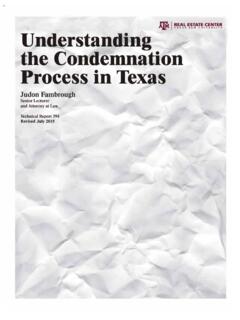Transcription of IN-STATE TUITION - Working for a Better Texas
1 IN-STATE TUITION . for NON-CITIZEN RESIDENT TEXANS. WHAT YOU NEED TO KNOW. What is How does HB 1403 affect the ability 0%. HB 1403? of Texas citizens to get into Texas colleges? In 2001, the Texas Legislature passed HB. 1403, also known as the Texas Dream Act, HB 1403 does not impact admission which extends IN-STATE TUITION and grant decisions in any way. All students eligibility to non-citizen residents of the regardless of immigration status state. compete equally for admission to Texas institutions of higher education. IN-STATE TUITION and state financial aid programs are available to residents of Texas . A student that is not a citizen How many students benefit from or permanent resident is considered a resident of Texas for higher education HB 1403? purposes if they can demonstrate: In 2013, 24,770 non-citizen resident students out of 1,303,684 total students They lived in Texas during the three years before graduating from high school or receiving a ( percent of total students) paid IN-STATE TUITION under HB 1403.
2 This includes Texas public universities, public General Equivalency Diploma community, technical and state colleges, (GED); and public health related They lived in Texas the year before enrolling at a Texas public college or university; NON-CITIZEN. RESIDENT STUDENTS. AND. They sign an affidavit declaring their intention to apply for Legal Permanent Resident status as soon as they are HB 1403 affects non-citizen students who are documented and students who are TOTAL Texas . undocumented. STUDENTS. IN-STATE TUITION - WHAT YOU NEED TO KNOW. How many non-citizen resident students receive state financial aid, loans and grants in Texas ? Only 4,109 non-citizen resident students ( percent of total students) received state- authorized loans, state-supported grants, and other institutional/non-state financial aid in How many non-citizen resident students receive state-supported grants in Texas , and how much do they receive?
3 Only 2,318 non-citizen resident students received state-supported grants ( percent of all students who received grants), at a cost of $ OF ALL Texas STUDENTS TO RECEIVE GRANT In total, over $430 million in state-supported AID ARE NON-CITIZEN grants was distributed to over 130,000 students RESIDENT STUDENTS across Texas in How do Texas Dream Act students and other immigrants contribute to the Texas economy? Non-citizen resident students paid $ million in TUITION and fees in $ M. PAID IN TUITION AND FEES. In 2010, undocumented immigrants in $65B. Texas paid an estimated $ billion in state and local taxes. In part, these taxes help support Texas institutions of higher In 2011, immigrants of all status contributed $65 billion in economic output to the state in terms of wages, salary, and business IN ECONOMIC OUTPUT.
4 WAGES, SALARY, & BUSINESS EARNINGS. IN-STATE TUITION - WHAT YOU NEED TO KNOW. HB 1403 Students Attend College All Over the State HB 1403 Students by Region 34 - 64. 65 - 595. 536 - 3853. 3854 - 8747. Higher Education Regions 1. High Plains 2. Northwest 3. Metroplex 4. Upper East 5. Southeast 6. Gulf Coast 7. Central Texas 8. South Texas 9. West Texas 10. Upper Rio Grande Valley Source: Texas Higher Education Coordinating Board. Produced by CPPP in March 2015. Note: Texas State Technical Colleges not included. Hill College is included in Central Texas region. 17,726 17,628. 24,736 TOTAL STUDENTS. HB 1403 STUDENTS HB 1403 STUDENTS. ATTEND COMMUNITY ATTEND RURAL. AND TECHNICAL COLLEGES. COLLEGES. 7,010 7,108. HB 1403 STUDENTS HB 1403 STUDENTS. ATTEND 4-YEAR COLLEGES ATTEND URBAN COLLEGES.
5 ENDNOTES. 1 Section of the Texas Education Code 2 Overview: Eligibility for IN-STATE TUITION and state financial aid programs. Texas Higher Education Coordinating Board. October, 2015. 3 Overview: Eligibility for IN-STATE TUITION and state financial aid programs. Texas Higher Education Coordinating Board. October, 2015. 4 Overview: Eligibility for IN-STATE TUITION and state financial aid programs. Texas Higher Education Coordinating Board. October, 2015. 5 Report on Student Financial Aid in Texas Higher Education for Fiscal Year 2012. Texas Higher Education Coordinating Board. June, 2014. (State-supported grant programs include: Texas Grants, TUITION Equalization Grant Program, Top 10% Scholarship Program, Texas Educational Opportunity Grant, and Texas College Work-Study Program).
6 6 Overview: Eligibility for IN-STATE TUITION and state financial aid programs. Texas Higher Education Coordinating Board. October, 2015. 7 Undocumented Immigrants' State and Local Tax Contributions. Institute on Taxation and Economic Policy. July, 2013. 8 Economic Policy Institute analysis, State of Working Texas , 2007-2011 American Community Survey (ACS). THE CENTER FOR PUBLIC POLICY PRIORITIES is an independent public policy organization that uses research, analysis and advocacy to promote solutions that enable Texans of all backgrounds to reach their full potential. Learn more at For more information, please contact Oliver Bernstein at or call @CPPP_TX


